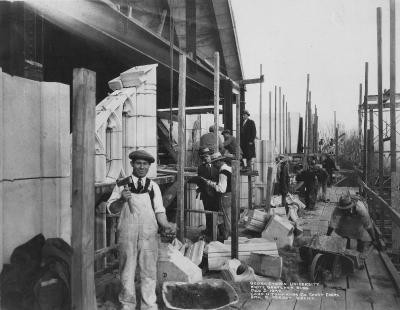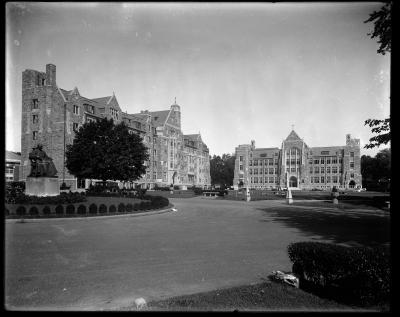White-Gravenor Hall, located across the front lawn from Lauinger Library and next to Red Square, currently houses classrooms, offices for the Georgetown College deans, the University Registrar, and the Office of Undergraduate Admissions.
Design and Construction
In the 1920s, the University developed plans for a campus expansion and the construction of a new “Andrew White Quadrangle.” The Quadrangle would be comprised of Copley Hall, White-Gravenor Hall, and a Museum Building, located parallel to 37th Street. However, under the funding constraints imposed by the Great Depression, the Museum Building was never constructed.
In 1932, then University President Rev. Coleman Nevils, S.J. announced that construction crews would begin breaking ground for a new building, designed by Emile G. Perrot, on the north side of the old athletic field. In part, the University hoped to provide work for construction workers who were unemployed as the Depression delayed large projects. The University did not have enough to fund the building through completion when construction began, and the Charles H. Tompkins Company of Washington had contracted to suspend construction should funds run out.1The principal source of funding had come from the the sale of eighty acres along Reservoir Road, which Brother Jonathan West had donated to the University in the 1820s. This land, directly across from the Georgetown School of Medicine, now houses the French Embassy. In honor of West’s donation, there is a shield bearing the name “West” over the White-Gravenor’s western entrance.
Construction was completed on the new 77,824 square foot building on June 7, 1933. The building’s exterior matches the architectural Neo-Gothic Scholastic style of Copley, but also honors the history of Georgetown through stained glass and detailed masonry. Five shields are engraved above the buildings center door, and each shield represents the five academies founded by the Jesuits in Maryland before Georgetown: St. Mary’s City (1634), Calverton Manor (1640), Newton Manor (1677), Bohemia Manor (1745), and Georgetown Heights (1789).
Name and Initial Facilities
White-Gravenor’s name honors two of the original Jesuits in Southern Maryland who came with Lord Baltimore in 1634 aboard the Ark and Dove. Fr. Andrew White and Fr. John Altham Gravenor were among the 140 Englishmen who founded the colony at St. Mary’s City. Fr. White was forcibly returned to England during the Cromwell era and arrested for being a Jesuit in England. He defended his presence as involuntary, and was subsequently acquitted. Fr. Gravenor remained in Maryland and worked with the Piscataway Native Americans.2
When it opened, White-Gravenor provided twenty additional classrooms, housed the offices of the Dean and Registrar, and kept the vaults storing the University’s records. The biology department moved to the building’s top floor, where there were new laboratories with skylights, ventilation, and new equipment for storing biological specimens.3The building’s 760 square foot stone esplanade was designed as a space for future graduations.4
Renovations and Additions
In 1974, the University spent an estimated $1.6 million renovating White-Gravenor. The bookstore was relocated to the garage under Lauinger Library, the Office of the Registrar was moved to the basement, the Admissions offices were expanded, classrooms were soundproofed to block out the roar of jet planes from National Airport, and the psychology labs were moved to the third floor. Funding for these changes came from a $1.34 million federal loan and $160,000 from the University’s Contingency Fund for Deferred Maintenance.5
In 2000, following the death of former professor Jan Karski (SFS ‘52), the University unveiled a statue next to White-Gravenor in his honor. As a Polish citizen during WWII, Karski escaped a Soviet camp and joined the underground resistance, where he witnessed the Warsaw Ghetto and the transportation of Jews to concentration camps. He then notified British authorities and met with President Roosevelt. Karski remained in the United States after the war, earned his Ph.D. from the School of Foreign Service, and became a professor of government and international affairs. The statute depicts an older Karski sitting on a bench with a cane in his hand and chessboard beside him.6 That same year, following the death of a student during an altercation outside Lauinger, the University unveiled the David Shick Memorial. On the east side of White-Gravenor, paid for by donations from friends, family, and students, there is a small koi pond with flowers, stonework, greenery, and two cascading waterfalls.7
In 2004, the University installed a statute of St. Ignatius of Loyola on the esplanade outside the main entrance of White-Gravenor. Designed by Vicki Winters-Reid and known as “The Pilgrim,” the bronze statute depicts St. Ignatius with staff in hand. Mr. and Mrs. John E. Rooney (COL '48, LAW '51) gifted the statute in memory of Fr. Royden B. Davis, S.J., Dean of the College from 1966 to 1989.
In 2019, construction began on a new ramp to the front entrance of the building in an effort to expand ADA accessibility while preserving the building's historic design. Previously, the building’s only ramp was on the east side of the building and led to the basement.8
- 1“Ground Broken for Erection of White-Gravenor Recitation Hall.” The Hoya. 16 March 1932, p.1.
- 2Francis X. Ballman, "White-Gravenor Hall," Building Outlines Campus Buildings, 1789 – 1995, Father Lawrence Hurley Memorial Edition, Francis X. Ballmann and the Division of Facilities, 1995, p. 99-101.
- 3“Ground Broken for Erection of White-Gravenor Recitation Hall.”
- 4“Archbishop Curley Dedicates White-Gravenor Science Hall.” The Hoya. 14 Dec. 1932, p.1.
- 5Bob Hayes, “Earmarks $1.6 Million For White-Gravenor.” The Hoya. 11 Feb. 1972, p.1.
- 6“Six People to Know at Georgetown.” The Georgetown Voice. 26 Aug. 2011.
- 7Anne Rittman, “Memorial Dedicated to Shick.” The Hoya. 17 Oct. 2000.
- 8Meredith Miller, “White-Gravenor Ramp Planned to Increase Accessibility.” The Hoya. 7 Nov. 2018.





